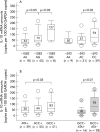Cytokine gene polymorphisms influence mucosal cytokine expression, gastric inflammation, and host specific colonisation during Helicobacter pylori infection
- PMID: 15247172
- PMCID: PMC1774164
- DOI: 10.1136/gut.2003.029736
Cytokine gene polymorphisms influence mucosal cytokine expression, gastric inflammation, and host specific colonisation during Helicobacter pylori infection
Abstract
Background and aims: Recent studies linked cytokine gene polymorphisms to H pylori related gastric cancer development. The current study evaluated the role of cytokine gene polymorphisms for mucosal cytokine expression, the gastric inflammatory response, and bacterial colonisation during H pylori infection.
Patients and methods: In 207 H pylori infected patients with chronic gastritis, polymorphisms at different loci of the interleukin (IL)-10, IL-1B, IL-1 receptor antagonist (IL-1RN), tumour necrosis factor (TNF)-A, and interferon (IFN)-G genes were genotyped by polymerase chain reaction (PCR), restriction fragment length polymorphism (RFLP) analysis, and allelic discriminating TaqMan PCR. Mucosal cytokine mRNA copy numbers were determined by real time quantitative PCR. Presence of bacterial virulence factors was investigated by cagA, vacAs1/2, and babA2 PCR. Biopsies were assessed with regard to the degrees of granulocytic/lymphocytic infiltration and the presence of intestinal metaplasia (IM) and atrophic gastritis (AG).
Results: Proinflammatory IL-1 polymorphisms (IL-1RN*2(+)/IL-1B-511T/-31C(+)) were associated with increased IL-1beta expression, more severe degrees of inflammation, and an increased prevalence of IM and AG. Carriers of the IL-10-1082G/-819C/-592C alleles (GCC haplotype) had higher mucosal IL-10 mRNA levels than ATA haplotype carriers and were associated with colonisation by more virulent cagA(+), vacAs1(+), and babA2(+) H pylori strains. The TNF-A-307(G/A) and IFN-G+874(A/T) polymorphisms did not influence mucosal cytokine expression or the inflammatory response to H pylori.
Conclusions: Cytokine gene polymorphisms influence mucosal cytokine expression, gastric inflammation, and the long term development of precancerous lesions in H pylori infection. Host polymorphisms are associated with certain bacterial strain types, suggesting host specific colonisation or adaptation. These findings contribute to the understanding of the complex interplay between host and bacterial factors involved in the development of gastric pathology.
Figures





Comment in
-
Role of IL-10 promoter haplotypes in Helicobacter pylori associated gastric inflammation.Gut. 2005 Jun;54(6):888. Gut. 2005. PMID: 15888803 Free PMC article. No abstract available.
Similar articles
-
H. pylori genotypes and cytokine gene polymorphisms influence the development of gastric intestinal metaplasia in a Chinese population.Am J Gastroenterol. 2006 Apr;101(4):714-20. doi: 10.1111/j.1572-0241.2006.00560.x. Am J Gastroenterol. 2006. PMID: 16635219
-
Pro- and anti-inflammatory cytokines gene polymorphisms and Helicobacter pylori infection: interactions influence outcome.Cytokine. 2005 Feb 21;29(4):141-52. doi: 10.1016/j.cyto.2004.10.013. Epub 2004 Dec 8. Cytokine. 2005. PMID: 15652446
-
Synergistic effect of Helicobacter pylori virulence factors and interleukin-1 polymorphisms for the development of severe histological changes in the gastric mucosa.J Infect Dis. 2003 Jul 15;188(2):272-81. doi: 10.1086/376458. Epub 2003 Jul 3. J Infect Dis. 2003. PMID: 12854083
-
Helicobacter pylori Infection Synergistic with IL-1β Gene Polymorphisms Potentially Contributes to the Carcinogenesis of Gastric Cancer.Int J Med Sci. 2016 Apr 8;13(4):298-303. doi: 10.7150/ijms.14239. eCollection 2016. Int J Med Sci. 2016. PMID: 27076787 Free PMC article. Review.
-
Influence of inflammatory cytokine polymorphisms on eradication rates of Helicobacter pylori.J Gastroenterol Hepatol. 2009 Nov;24(11):1725-32. doi: 10.1111/j.1440-1746.2009.06047.x. J Gastroenterol Hepatol. 2009. PMID: 20136959 Free PMC article. Review.
Cited by
-
Cytokine Polymorphisms, Their Influence and Levels in Brazilian Patients with Pulmonary Tuberculosis during Antituberculosis Treatment.Tuberc Res Treat. 2013;2013:285094. doi: 10.1155/2013/285094. Epub 2013 Mar 27. Tuberc Res Treat. 2013. PMID: 23634300 Free PMC article.
-
Interleukin10 -592 promoter polymorphism associated with gastric cancer among Asians: a meta-analysis of epidemiologic studies.Dig Dis Sci. 2010 Jun;55(6):1525-32. doi: 10.1007/s10620-009-0922-1. Epub 2009 Aug 11. Dig Dis Sci. 2010. PMID: 19669876 Review.
-
Clinical relevance of the interleukin 10 promoter polymorphisms in Chinese Han patients with major trauma: genetic association studies.Crit Care. 2009;13(6):R188. doi: 10.1186/cc8182. Epub 2009 Nov 26. Crit Care. 2009. PMID: 19939284 Free PMC article.
-
Role of cyclooxygenase-2 functional gene polymorphisms in Helicobacter pylori induced gastritis and gastric atrophy.Mol Cell Biochem. 2009 Jan;321(1-2):103-9. doi: 10.1007/s11010-008-9924-0. Epub 2008 Sep 30. Mol Cell Biochem. 2009. PMID: 18825488
-
Ethnic differences in gastric cancer genetic susceptibility: allele flips of interleukin gene.World J Gastroenterol. 2014 Apr 28;20(16):4558-65. doi: 10.3748/wjg.v20.i16.4558. World J Gastroenterol. 2014. PMID: 24782608 Free PMC article. Review.
References
-
- Suerbaum S , Michetti P. Helicobacter pylori infection. N Engl J Med 2002;347:1175–86. - PubMed
-
- Covacci A , Telford JL, Del GG, et al. Helicobacter pylori virulence and genetic geography. Science 1999;284:1328–33. - PubMed
-
- Prinz C , Schoniger M, Rad R, et al. Key importance of the Helicobacter pylori adherence factor blood group antigen binding adhesin during chronic gastric inflammation. Cancer Res 2001;61:1903–9. - PubMed
Publication types
MeSH terms
Substances
LinkOut - more resources
Full Text Sources
Other Literature Sources
Medical
Research Materials
